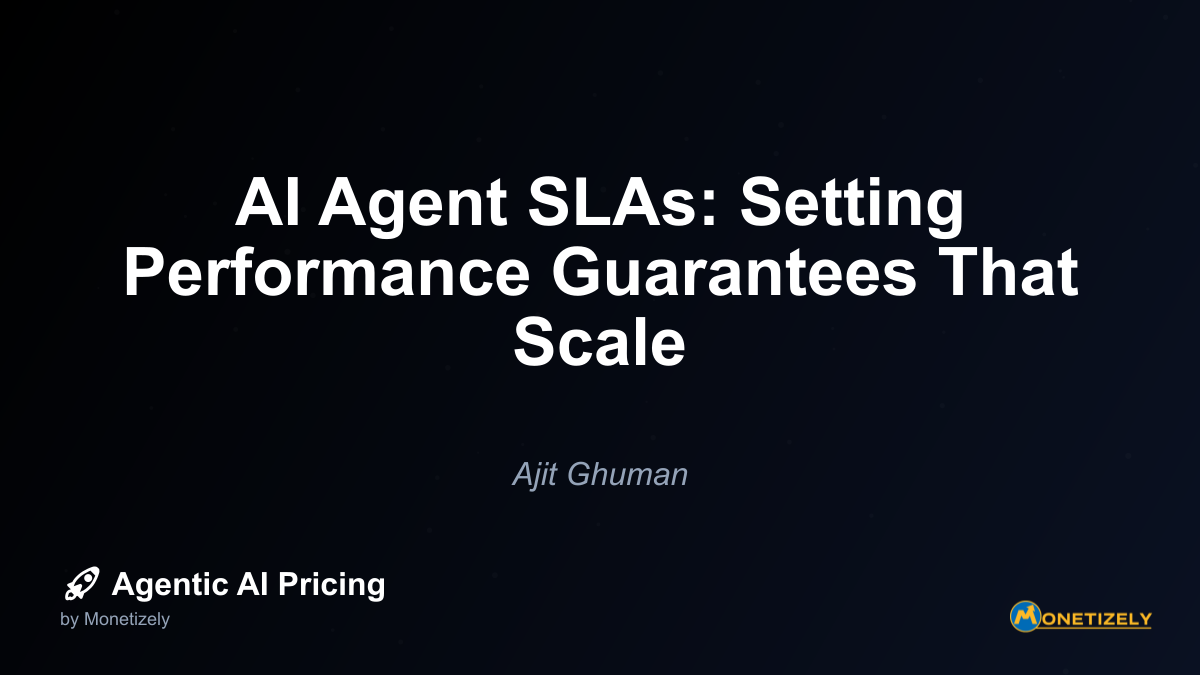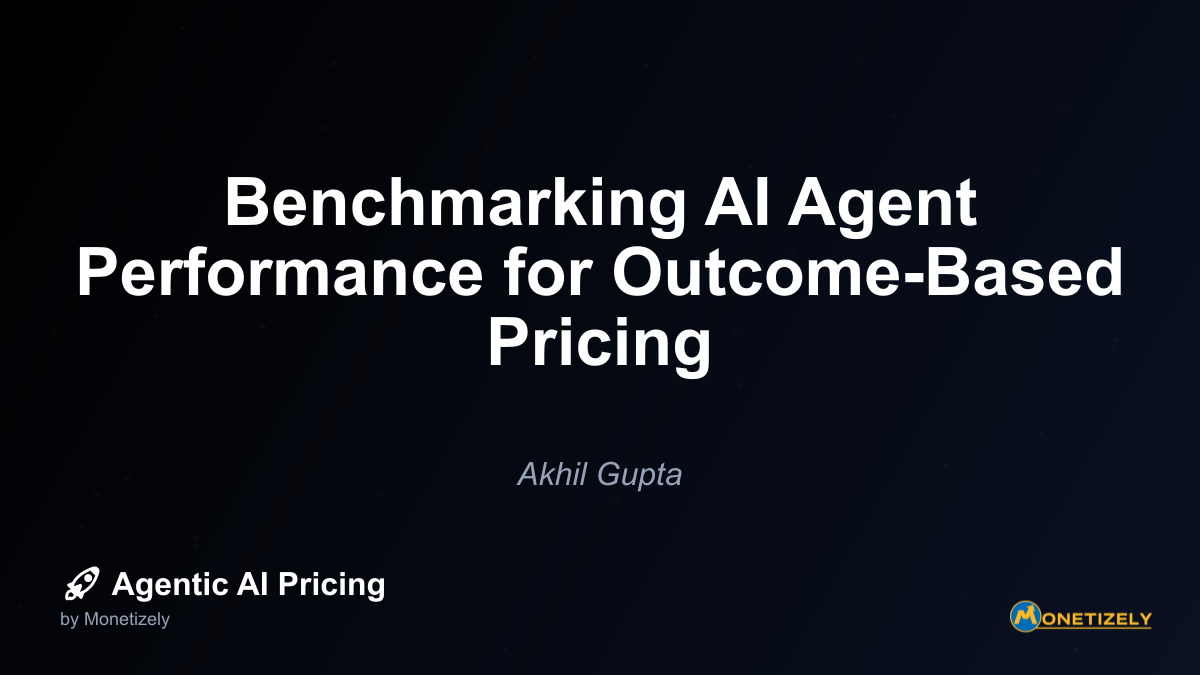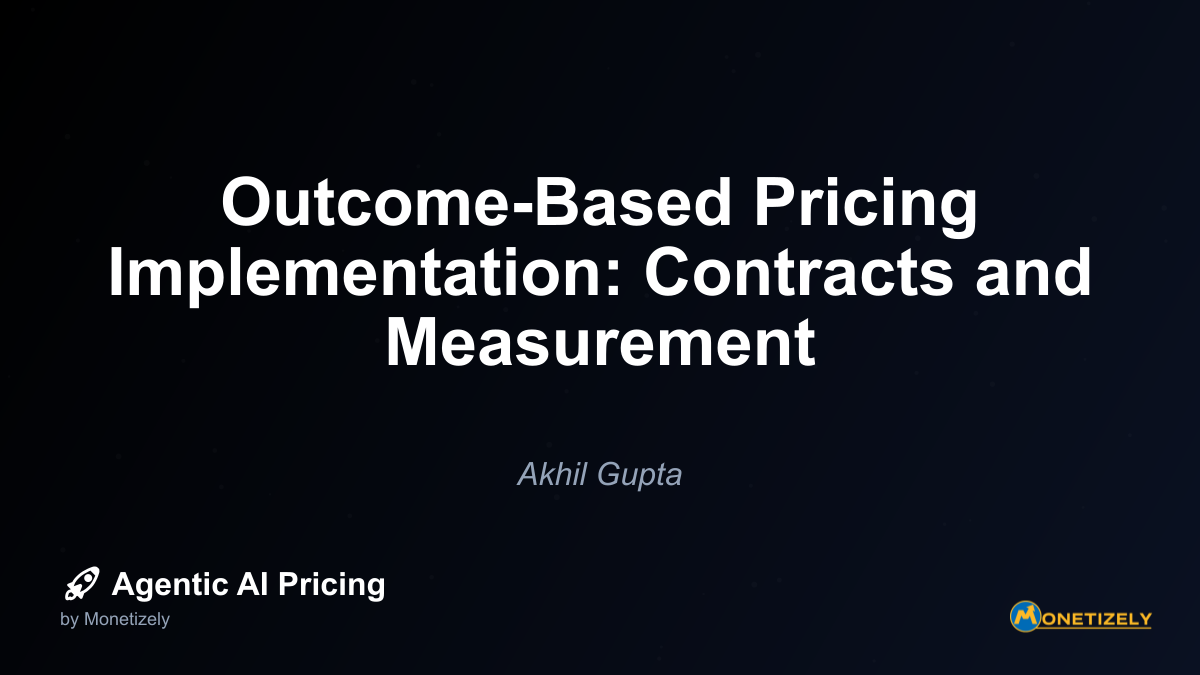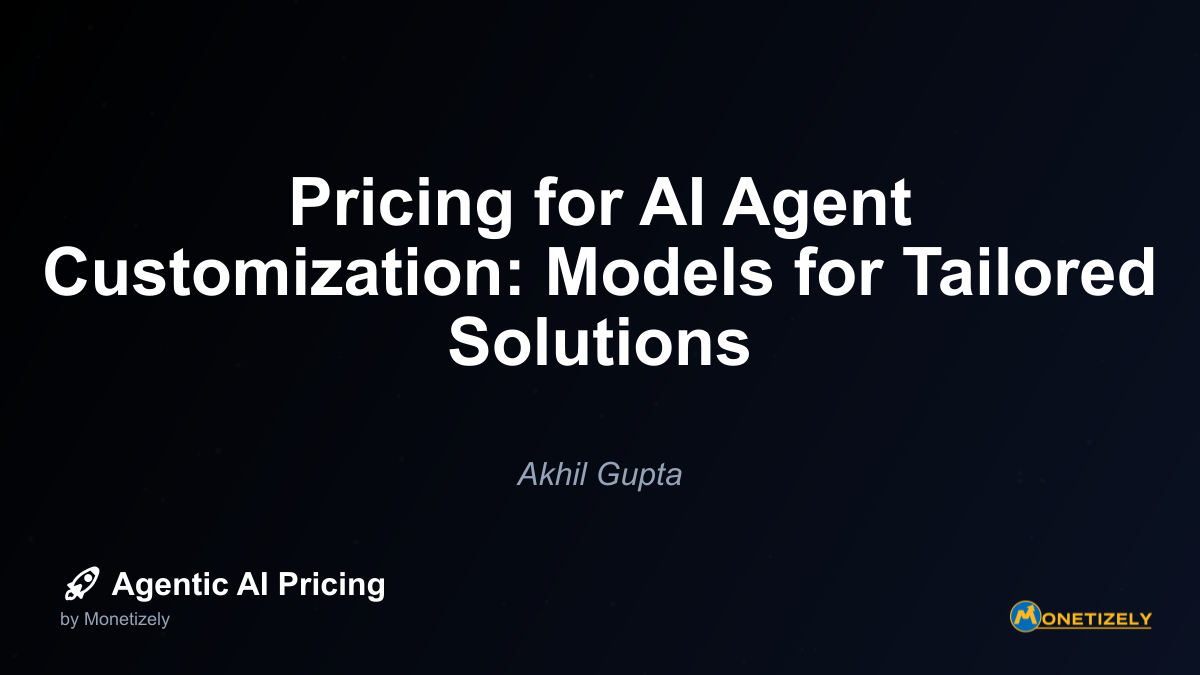· Ajit Ghuman · Implementation · 12 min read
Pricing the Training Phase: Models for AI Agent Implementation
AI and SaaS Pricing Masterclass
Learn the art of strategic pricing directly from industry experts. Our comprehensive course provides frameworks and methodologies for optimizing your pricing strategy in the evolving AI landscape. Earn a professional certification that can be imported directly to your LinkedIn profile.
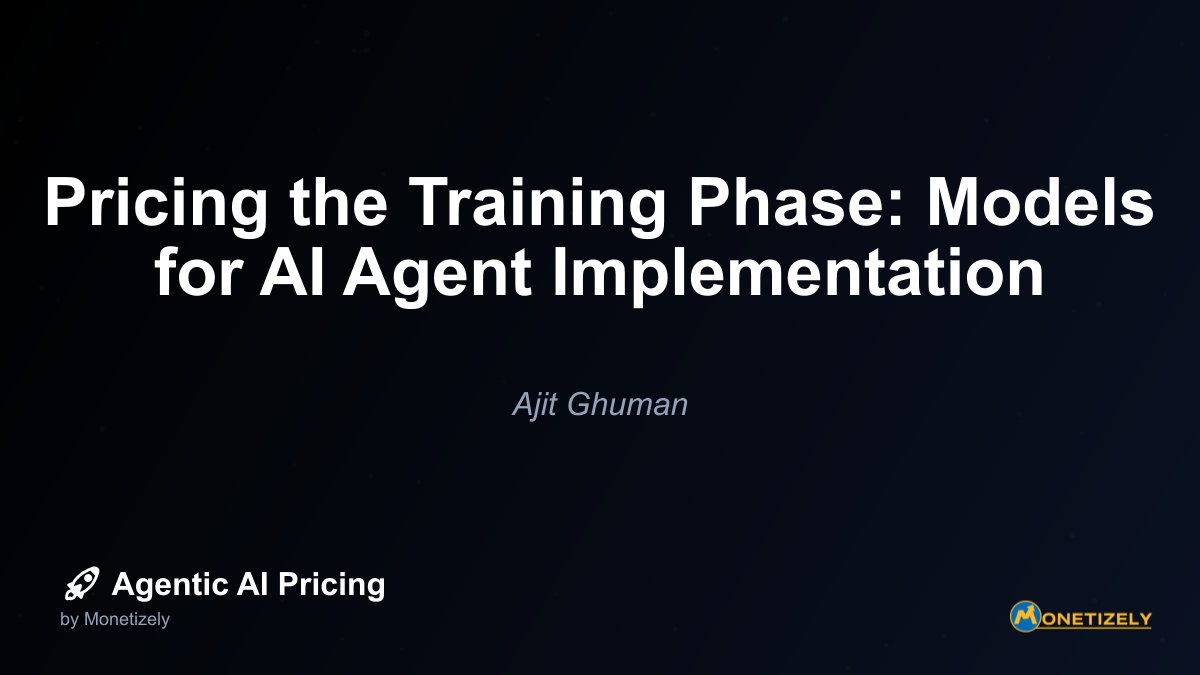
In today’s rapidly evolving AI landscape, organizations implementing AI agents face a critical decision point: how to price the initial training and setup phase that precedes full deployment. This phase represents a significant investment but also sets the foundation for long-term success. The pricing strategies adopted during this period can determine not only immediate revenue but also customer satisfaction, competitive positioning, and sustainable growth.
The Strategic Importance of Training Phase Pricing
The training phase for AI agents represents a unique pricing challenge. Unlike traditional software implementation, AI agents require customization, data integration, and iterative refinement before delivering their full value. This creates a tension between recovering upfront costs and demonstrating value to customers who may not yet experience the full benefits.
According to recent research from Boston Consulting Group, companies are increasingly moving away from one-size-fits-all pricing models for AI implementation. Instead, they’re adopting sophisticated approaches that reflect the true economics of AI agent training while aligning with customer expectations and value perception.
Understanding the Economics of AI Agent Training
Cost Components of the Training Phase
The training phase for AI agents encompasses several distinct cost elements that must be considered in pricing strategies:
Computational Resources - Training sophisticated AI agents, particularly those built on large language models (LLMs), requires significant computational power. According to CUDO Compute research, training costs for large-scale models can range from $40 million to over $100 million for state-of-the-art systems like GPT-4 or Google’s Gemini Ultra.
Data Collection and Preparation - High-quality, relevant data is essential for effective AI training. This often involves costs for data acquisition, cleaning, annotation, and validation.
Engineering Talent - AI specialists command premium salaries ($150,000-$250,000 annually per specialist) for designing, implementing, and refining AI agents during the training phase.
Integration Work - Connecting AI agents to existing systems and workflows requires integration expertise and customization efforts.
Testing and Quality Assurance - Ensuring AI agents function correctly and safely demands rigorous testing protocols.
Knowledge Transfer - Training customer teams to work effectively with the AI agent adds another layer of cost.
Research from Scale Up Ally indicates that AI agent development costs typically range from $20,000 for basic implementations to over $150,000 for advanced, multi-system AI agents with extensive customization requirements.
Dominant Pricing Models for the Training Phase
The market has evolved several distinct pricing approaches for the AI agent training phase, each with unique advantages and considerations:
1. Separate Setup Fee Model
This straightforward approach charges an upfront fee for the training phase, followed by recurring subscription or usage fees once the agent is deployed.
Example Structure:
- Initial setup/training fee: $5,000-$100,000+ depending on complexity
- Followed by monthly subscription: $499-$1,500+ based on usage tiers
Advantages:
- Clear separation between implementation and ongoing costs
- Recovers upfront investment quickly
- Sets appropriate expectations for the investment required
Challenges:
- May create a high barrier to adoption
- Difficult to adjust if training complexity changes
- Customer bears most of the risk if implementation fails
ManoByte’s research shows this model is particularly common for enterprise implementations where customers understand the value of customization and have budget cycles that accommodate capital expenditures.
2. Amortized Training Costs
This model spreads training costs across the subscription period, eliminating large upfront fees but resulting in higher recurring charges.
Example Structure:
- No or minimal upfront fee
- Higher monthly subscription: $999-$2,500+ for 12-24 months
- Potentially reduced rates after initial contract period
Advantages:
- Lower adoption barrier
- Aligns with SaaS budgeting expectations
- Provider maintains incentive for successful implementation
Challenges:
- Requires longer commitment periods to recover costs
- Higher risk for the provider if customers churn
- May obscure the true cost of implementation
According to Teneo AI research, this model has gained popularity as organizations seek to shift from capital to operational expenditures for AI initiatives.
3. Milestone-Based Pricing
This approach breaks the training phase into distinct milestones with payments tied to completion of each stage.
Example Structure:
- Discovery/planning payment: 20% of total
- Initial implementation: 30% of total
- Testing and refinement: 30% of total
- Successful deployment: 20% of total
Advantages:
- Aligns payment with tangible progress
- Shares risk between provider and customer
- Creates natural checkpoints for project evaluation
Challenges:
- Administrative complexity in defining and verifying milestones
- Potential disagreement about milestone completion criteria
- May extend sales and negotiation cycles
This model is increasingly popular for complex implementations where the scope may evolve during the training process.
4. Outcome-Based Setup Pricing
Some innovative providers are linking training phase pricing to measurable outcomes achieved during or shortly after implementation.
Example Structure:
- Minimal base setup fee
- Performance bonuses tied to specific metrics (accuracy rates, task completion, etc.)
- Transition to outcome-based ongoing pricing
Advantages:
- Strongly aligns provider incentives with customer success
- Reduces perceived risk for customers
- Differentiates providers confident in their capabilities
Challenges:
- Requires clear, measurable success criteria
- More complex contracts and monitoring
- Potential for disagreement about attribution
Ibbaka Market Research notes this model is gaining traction particularly in competitive markets where providers seek to differentiate through confidence in their implementation capabilities.
5. Training Phase as Free or Discounted Trial
Some providers offer reduced or waived training costs in exchange for longer commitment periods or as a competitive differentiator.
Example Structure:
- Free or heavily discounted implementation
- Longer minimum contract term (24-36 months)
- Higher ongoing subscription fees
Advantages:
- Eliminates initial adoption barrier
- Creates compelling competitive differentiation
- Shifts focus to long-term relationship
Challenges:
- Requires confidence in low customer churn
- May attract price-sensitive customers with higher support needs
- Potential for negative unit economics if implementation costs are high
This approach is most common among well-funded startups seeking market share or established players entering new market segments.
Industry-Specific Pricing Approaches for AI Training
Different industries have developed distinct approaches to pricing AI agent training phases based on their unique requirements, risk profiles, and value expectations:
Healthcare
The healthcare industry faces stringent regulatory requirements and high stakes for AI implementation, driving particular pricing approaches:
- Higher upfront investment in validation and compliance documentation
- Phased implementation with clear milestone payments
- Risk-sharing models that tie portions of payment to successful regulatory approval
- Extended training periods to ensure accuracy and safety
For example, clinical documentation AI agents typically involve setup fees of $50,000-$100,000 with extensive validation requirements before full deployment.
Financial Services
Financial institutions prioritize security, accuracy, and compliance in AI implementations:
- Premium pricing for enhanced security features and compliance documentation
- Performance guarantees with financial penalties for errors
- Graduated pricing based on financial risk exposure
- Hybrid models combining fixed fees with performance-based components
AI agents for fraud detection or risk modeling often command training phase prices 30-40% higher than comparable implementations in other industries due to these requirements.
Manufacturing
Manufacturing AI implementations typically focus on operational efficiency and integration with existing systems:
- Integration-based pricing scaled to the number of connected systems
- Pilot-to-production models with incremental investment
- ROI-based pricing tied to efficiency gains or cost reduction
- Time-based billing for extended implementation periods
Predictive maintenance AI agents might start with a $15,000-$30,000 pilot implementation before scaling to full production with additional integration fees.
Retail
Retail organizations typically prioritize quick time-to-value and measurable revenue impact:
- Seasonal timing considerations affecting implementation pricing
- Revenue-share models for AI agents directly affecting sales
- A/B testing approaches with performance-based pricing
- Tiered implementation options based on feature requirements
Customer service AI agents in retail might offer basic implementation for $10,000-$20,000 with premium customization options available at higher price points.
Calculating Training Costs and Setting Prices
Determining appropriate pricing for the AI agent training phase requires a systematic approach to cost calculation and strategic pricing decisions.
Framework for Cost Calculation
Direct Labor Costs
- Engineering hours × hourly rate
- Project management time
- QA and testing resources
- Training and documentation development
Infrastructure Costs
- Computing resources for training
- Storage requirements
- Network usage
- Environment setup and maintenance
Data Costs
- Acquisition of training data
- Cleaning and preparation
- Annotation and labeling
- Validation datasets
Opportunity Costs
- Resource allocation trade-offs
- Time-to-market considerations
- Competitive positioning impact
Strategic Pricing Considerations
Beyond pure cost recovery, effective pricing strategies for the training phase should consider:
Value-Based Components
- Expected ROI for the customer
- Strategic importance to customer’s business
- Competitive alternatives
- Unique capabilities offered
Market Positioning Factors
- Competitive landscape analysis
- Price sensitivity in target segment
- Brand and reputation effects
- Long-term relationship value
Risk Allocation
- Implementation complexity assessment
- Success probability analysis
- Customer readiness evaluation
- Contractual safeguards
According to Monetizely research, the most successful providers typically price the training phase at 1.5-2.5x direct costs, with the multiplier varying based on market positioning, competitive intensity, and strategic objectives.
Case Studies: Training Phase Pricing in Practice
Case Study 1: Salesforce Agentforce
Salesforce’s approach to AI agent implementation demonstrates a sophisticated evolution in training phase pricing:
Initial Approach (2023):
- Standard implementation fee: $75,000-$150,000
- Fixed timeline: 8-12 weeks
- Limited customization options
Evolved Model (2025):
- Tiered implementation options:
- Starter ($50,000): Basic configuration, limited integrations
- Professional ($100,000): Advanced customization, multiple integrations
- Enterprise ($200,000+): Full custom development, complex workflows
- Outcome-based components tied to specific metrics
- Risk-sharing options for strategic accounts
Results:
- 40% increase in implementation success rate
- 25% higher customer satisfaction
- 15% reduction in time-to-value
- Improved competitive win rate against lower-priced alternatives
Case Study 2: Sierra’s Resolution Pricing
Sierra, a customer service AI provider, implemented an innovative approach to training phase pricing:
Model:
- Minimal upfront fee ($10,000)
- Weekly progress payments during implementation
- Performance bonus tied to resolution rate improvements
- Transition to per-resolution pricing model after deployment
Results:
- 60% increase in new customer acquisition
- Reduced sales cycle by 45%
- Higher customer commitment to implementation success
- Improved margins through performance incentives
Case Study 3: Cognition AI’s Agent Compute Units
Cognition AI developed a transparent, resource-based approach to training costs:
Model:
- Pricing based on “Agent Compute Units” (ACUs)
- Clear correlation between resources used and price
- Customer controls implementation scope and cost
- Flexible scaling during training phase
Results:
- Improved customer trust through transparency
- 30% reduction in scope creep during implementation
- Better alignment between customer expectations and deliverables
- Higher conversion from implementation to production
Balancing Upfront Costs with Ongoing Revenue
One of the most challenging aspects of pricing AI agent training is balancing the recovery of substantial upfront investments with the need to establish sustainable ongoing revenue streams. Several approaches have proven effective:
1. Contract Length Adjustments
Longer contract commitments can justify reduced upfront training fees:
- 12-month contract: 100% of standard training fee
- 24-month contract: 75% of standard training fee
- 36-month contract: 50% of standard training fee
This approach ensures adequate revenue over the customer lifetime while reducing initial adoption barriers.
2. Usage Commitment Models
Minimum usage guarantees can offset reduced training fees:
- Standard training fee with no usage commitment
- 25% discount with minimum monthly usage commitment
- 50% discount with annual usage commitment paid upfront
This model works particularly well for consumption-based pricing where usage directly correlates with value delivered.
3. Tiered Implementation Options
Offering different levels of implementation allows customers to select their optimal investment level:
- Basic implementation: Essential features, limited customization
- Standard implementation: Full feature set, moderate customization
- Premium implementation: Advanced features, extensive customization
Each tier can be priced appropriately for the value delivered while giving customers control over their investment.
4. Success-Based Pricing Components
Adding performance incentives to implementation pricing creates alignment:
- Base implementation fee covering direct costs
- Success bonuses tied to agreed-upon metrics
- Accelerated ROI sharing during initial deployment
This approach reduces customer risk while allowing providers to capture additional value when implementations exceed expectations.
Technical Considerations Affecting Training Phase Pricing
Several technical factors significantly impact the economics of AI agent training and should be reflected in pricing strategies:
1. Model Complexity and Size
The scale and sophistication of the underlying AI models directly affect training costs:
- Small models (millions of parameters): Lower computational requirements
- Medium models (billions of parameters): Moderate training resources
- Large models (hundreds of billions of parameters): Extensive computational needs
Pricing should reflect these differences, with larger models commanding premium implementation fees due to their resource requirements.
2. Data Requirements
Data volume, quality, and preparation needs vary substantially:
- Pre-trained models with minimal customization: Limited data requirements
- Domain-specific fine-tuning: Moderate data needs with focused preparation
- Custom model training: Extensive data collection and preparation
Implementation pricing should account for these differences, with data-intensive implementations commanding higher fees.
3. Integration Complexity
The complexity of integrating AI agents with existing systems significantly impacts implementation costs:
- Standalone AI agents: Minimal integration requirements
- API-based integration: Moderate complexity
- Deep system integration: High complexity requiring extensive development
Integration complexity should be a key factor in training phase pricing, with more complex integrations justifying higher fees.
4. Pre-trained vs. Custom Models
The decision to use pre-trained models versus developing custom solutions has profound economic implications:
- Pre-trained models: 10-15% of the cost of custom development
- Fine-tuned pre-trained models: 20-30% of custom development costs
- Fully custom models: Highest cost but potentially greatest differentiation
Pricing strategies should reflect these differences, with custom development commanding significant premiums over pre-trained approaches.
Psychological Factors in Training Phase Pricing
The perceived value and willingness to pay for AI agent training is heavily influenced by psychological factors that savvy providers understand and address:
1. Value Perception and Cognitive Load
Research from Monetizely indicates that customers’ willingness to pay for AI agent training correlates strongly with the perceived cognitive complexity of the tasks the agent will perform. Agents handling complex, nuanced tasks command higher implementation fees because customers recognize the sophistication required.
Effective pricing strategies emphasize the cognitive load being automated rather than technical implementation details, connecting price to value rather than cost.
2. Price Anchoring Effects
How training costs are presented significantly impacts customer perception. Effective approaches include:
- Anchoring against the cost of traditional non-AI implementations
- Comparing to the fully loaded cost of human resources being augmented
- Presenting in the context of expected ROI or value creation
For example, framing a $50,000 implementation fee against a $500,000 annual cost reduction creates a compelling value proposition.
3. Risk Perception and Mitigation
Customers’ perception of implementation risk significantly affects their price sensitivity. Strategies to address risk concerns include:
- Money-back guarantees for failed implementations
- Phased payment structures tied to success milestones
- Reference customers in similar situations
- Transparent project plans with clear deliverables
By reducing perceived risk, providers can maintain premium pricing for the training phase while improving customer confidence.
4. Stakeholder-Specific Communication
Different stakeholders evaluate AI training investments through distinct lenses:
- Technical teams focus on capabilities, integration, and resource requirements
- Finance departments prioritize ROI, cost structures, and budget alignment
- Executives emphasize strategic impact, competitive advantage, and organizational transformation
Effective pricing communication adapts to these perspectives, emphasizing relevant aspects of the investment for each audience.
Communicating Training Phase Pricing to Different Stakeholders
Successful pricing strategies for AI agent training include tailored communication approaches for different stakeholders:
Technical Teams
When discussing pricing with technical stakeholders:
- Emphasize the technical sophistication and engineering quality
- Detail the resources, infrastructure, and expertise included
- Compare to the cost and complexity of internal development
- Highlight technical support and knowledge transfer components
Example: “Our implementation fee includes 300 engineering hours from AI specialists with an average of 8 years of experience, comprehensive testing protocols, and four weeks of side-by-side knowledge transfer with your team.”
Finance Departments
For financial decision-makers:
- Present clear ROI calculations with conservative assumptions
- Break down costs into familiar categories (labor, infrastructure, etc.)
- Offer flexible payment structures aligned with budget cycles
- Provide benchmarks against comparable investments
Example: “The $75,000 implementation fee represents
Co-Founder & CEO
Ajit is the author of Price To Scale, a top book on SaaS Pricing and is the Founder of Monetizely. Ajit has led and worked in pricing and product marketing at firms like Twilio, Narvar and Medallia. His work has been featured in Forbes and VentureBeat. Ajit regularly consults with software companies from Seed stage to post-IPO on pricing strategy. Ajit is also a highly-rated co-instructor for 'The Art of SaaS Pricing and Monetization' on Maven.
Pricing Strategy Audit
Let our experts analyze your current pricing strategy and identify opportunities for improvement. Our data-driven assessment will help you unlock untapped revenue potential and optimize your AI pricing approach.

